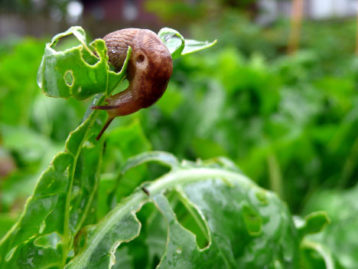Description
Slugs are slimy, rather gross creatures that eat plants and decomposing materials. Adults vary in colour from almost white to brown, grey and black. They prefer to feed at night. Snails resemble slugs with a shell, which they can hide in during the day. They will both however feed during the day in moist shady locations. Their movement is highly dependent upon moisture availability. They move by sliding forward on a trail of secreted slime. The slime has a silvery appearance and is often used to detect an infestation.
Effects
Snails and slugs feed on a variety of living plants and on decaying plant matter. They chew irregular holes with smooth edges in leaves and flowers and can clip succulent plant parts. They also can chew fruit and young plant bark. They leave discoloured patches in hardier leaves such as Swiss chard and beet greens.
Control
There are many ways to deal with slugs, but in an organic garden the best two are traps and handpicking. You should do both. Go out to your garden at dusk when the slugs are leaving their daytime hiding places and pick them off the underside of leaves and destroy. Mulching with crushed eggshells is a great method, but takes a lot of eggshells to be effective. The jagged edges discourage the slugs and snails.
You can trap snails and slugs beneath boards or flower pots that you position throughout the garden and landscape. Inverted melon rinds also make good traps. Construct wooden traps using 12″x 15″ boards (or any easy-to-handle size) raised off the ground by 1″ runners. The runners make it easy for the pests to crawl underneath. Scrape off the accumulated snails and slugs daily and destroy them; crushing is the most common method, but you can also drown them in a container filled with soapy water or rubbing alcohol. Don’t use salt to destroy snails and slugs, since it will increase soil salinity . Beer traps buried at ground level are also effective. They catch and drown slugs and snails that fall into them. Because it is the fermented part of the product that attracts these pests, you also can use a sugar-water and yeast mixture instead of beer.
